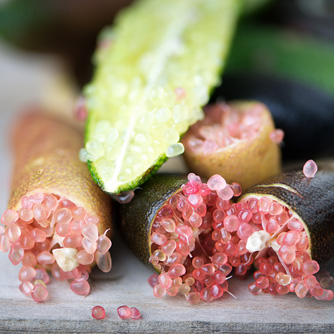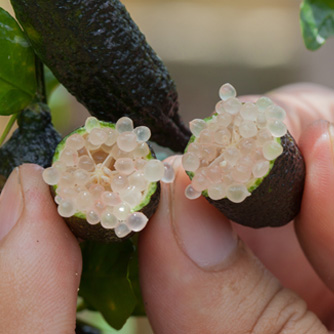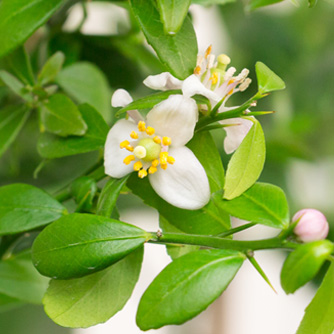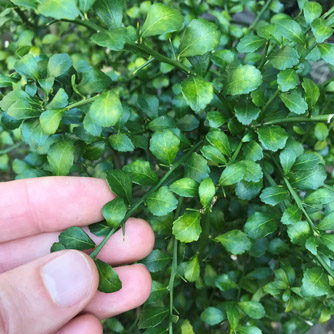Finger Limes
BackFinger limes (Citrus australasica) are a native citrus that produce elongated fruit which look like stubby little fingers. The pulp inside is made up of tiny translucent balls that are simply bursting with zestiness and what people love. To use the fruit simply cut it in half, squeeze the pulp out and add to seafood dishes, salads, desserts and even cocktails for a bit citrus zing.
Finger limes grow as a large dense shrub or small tree but if you have the space they also make a fabulous informal hedge that beneficial insects and birds will appreciate as much as you. It’s a win-win situation!
Finger Lime Varieties
In recent years there’s been an explosion finger lime cultivars released so you might be wondering which one to choose. Essentially they’re all the same when it comes to flavour with differences being in the size and colour of the fruit. The skin of the mature fruit can be green, burgundy or a dull orange while the pulp may be green, pale peach or red. Simply choose whichever appeals to you.
How to Grow Finger Limes
Finger limes grow naturally as an understory tree in the sub-tropical rainforests of south-east Queensland and north-east New South Wales. In the wild they can grow to 6m but in cultivation they usually stop at 3m which allows easy access to the fruit.
In nurseries you’ll commonly find grafted varieties which are suitable for growing in a wide range of soils and climates. They are usually prolific fruiters and should bear fruit within a year of planting. Grafted varieties are more expensive but worth it when you consider non-grafted forms can take up to 15 years before they begin producing fruit.

Finger lime fruit comes in a range of skin and pulp colours but they all taste the same
Finger limes grow well in either the ground or a large container and can be treated in much the same manner that you would treat traditional lemons, limes and other citrus. This means positioning them in a sunny or lightly shaded spot where it’s protected from heavy frost and strong winds. As an understory plant they can handle more shade than regular citrus but will produce less fruit. Note that in dryer regions with scorching hot summer sun some afternoon shade is necessary to prevent burn.
When planting in the ground finger limes do best in well-drained soil with a pH of between 6 and 7. To improve the soil before planting work in some compost and manure. Into clay soils add some gypsum and create a raised mound to further improve drainage. Ensure the finger lime is planted to the same depth that it was in the pot as this will ensure the graft union is at least 10cm above the ground.
After planting water in with a solution of OCP eco-seaweed to settle the soil around the roots, reduce transplant shock and encourage new roots. Then add a layer of mulch but keep a 5-10cm gap around the trunk to prevent fungal problems developing.
If planting into a container use a premium quality potting mix and a pot with a minimum diameter of 50cm. The bigger the better really so if you’ve got the space go larger. Water in with OCP eco-seaweed and mulch the surface as well.

Finger limes ready to pick
Fertilising and Maintenance of Finger Limes
Finger limes like other citrus are hungry plants and will benefit from regular feeding. Fertilise in spring, summer and autumn with a layer of compost, manure and organic pellets. In warm climates trees this can be done in winter too as the plant will still be active. In addition every 2-4 weeks apply a dose of OCP eco-aminogro with OCP eco-seaweed to ensure an abundant harvest. This is especially important for young establishing plants and those grown in containers.
For optimum cropping, water your finger lime thoroughly during flowering and fruiting. They have a relatively shallow root system and will appreciate the regular watering. As long as you know your plant is getting enough water don’t be too alarmed if your finger lime starts losing leaves for no apparent reason. This occurs regularly with nursery stock and given time they grow back. If die-back occurs on any stems, prune to just above a healthy node and the stem will usually reshoot.
Remove any shoots which appear below the graft union as this is the rootstock.
Finger limes don’t require any fancy pruning. Simply remove any dead or damaged wood periodically. Otherwise just prune if you wish to restrict the height or encourage into a hedge or ball shape.
Harvesting Finger Limes
Finger limes should only be harvested when they’re ripe as they don’t ripen any further once removed from the tree. Ripe fruit will feel firm to the touch and detach easily. With some varieties the skin will also change colour. Check around the base of the tree daily and pick up any fallen fruit.

The tasty pulp pearls can be easily squeezed from the fruit
Pests and Diseases of Finger Limes
Unfortunately citrus are vulnerable to quite a few problems and even though finger limes are a native plant they are no exception. Here are the main things to look out for:
- Sap suckers – Watch out for common pests like aphids, mites and scale that will draw energy from the tree. Spray with OCP eco-oil to control them.
- Sooty Mould – this black coating over foliage and fruit is actually a secondary issue caused by the feeding of sap sucker like aphids. So if you control the sap suckers (with sprays of OCP eco-oil) then the sooty mould will fade away.
- Citrus Leafminer – squiggly lines and distortion in the leaves indicate the juvenile leafminer at work. If it’s just one or two leaves then simply pull them off. If it’s more severe then hang the OCP eco-CLM Trap to catch the adults moths and break the cycle. You can also spray with OCP eco-oil which deters the moth from laying eggs but you’ll need to do this regularly whenever new foliage is developing.
- Citrus gall wasp – swollen lumps appearing on the branches is the work of the native citrus gall wasp. They lay eggs into young branches and as the larvae hatch and feed they cause a protective gall to develop. Over time these can reduce the health of the tree and fruiting potential. Cut off galls as soon as you spot them developing. Seal cuttings in a bag and leave in the sun for a couple of weeks to cook the wasp larvae.
- Fruit fly – it is more common for this pest to attack regular citrus fruit but if you find sting marks on your finger limes and maggots inside then you’ll need to adopt protective measures. This includes hanging the OCP eco-lure trap to monitor for their arrival each season and then using bait sprays or exclusion netting to protect the fruit.

Like all citrus finger limes produce small white flowers which are fragrant
- Caterpillars – there are a few caterpillars in the swallowtail butterfly family that commonly feed on citrus foliage including the orchard swallowtail and dainty swallowtail. As they turn into the most amazing butterflies we think it’s worth sacrificing a few leaves. If however you have a young tree and the defoliation is severe then simply move the caterpillars to another citrus tree to finish their life cycle. The caterpillars can look a bit fierce and shoot out a red forked gland when disturbed but they are harmless.
- Root rot – wilting and sudden death of the tree (usually with the dry leaves still clinging to the branches) is a sure sign of the fungal disease phytophthora which has destroyed the roots. Difficult to control organically it’s best to take preventative steps by only planting trees in soils which drain freely. Waterlogging stresses the tree as well as helping to spread the fungus. Incorporating lots of organic matter and regular use of OCP eco-seaweed may help by encouraging good microbes in the soil.
- Collar rot – cracking and rotting of the trunk is also caused by the phytophthora fungus. Cut away any damaged tissue and apply a copper or sulfur spray. Ensure mulch is always kept 10cm away from the trunk to prevent a build up of moisture and check that the soil doesn’t have any drainage issues.
Keeping your tree healthy by regular feeding and watering will go a long way to protecting it against many problems. This is important for all citrus.

Finger limes have much smaller leaves compared to other citrus and plenty of little thorns


